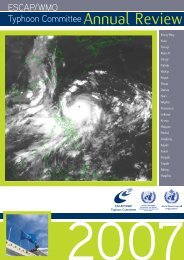TCAR - Typhoon Committee
TCAR - Typhoon Committee
TCAR - Typhoon Committee
You also want an ePaper? Increase the reach of your titles
YUMPU automatically turns print PDFs into web optimized ePapers that Google loves.
78<br />
ESCAP/WMO<br />
<strong>Typhoon</strong> <strong>Committee</strong> Annual Review 2009<br />
2.2.1 Meteorological Achievements/Results<br />
PRECIS (Providing Regional Climates for Impacts<br />
Studies)<br />
The Providing Regional Climates for Impacts Studies<br />
(PRECIS) regional climate model is being run at the<br />
Malaysian Meteorological Department (MMD) and the<br />
National University of Malaysia to study the impacts of<br />
various climate change scenarios for the 21stcentury<br />
over the South East Asian region. Lateral boundary<br />
data of future projection scenarios used are the<br />
HadCM3 ocean-atmospheric coupled projection<br />
(A1B scenario) and the HadAM3P atmospheric only<br />
(B2 and A2 scenarios) projection. The simulations<br />
were done for the South East Asian region at a<br />
horizontal resolution of 50 kilometers. Modifications<br />
were done to PRECIS in order to accommodate<br />
ECHAM5 lateral boundary data from the Max Planck<br />
Institute of Germany. The present version has also<br />
been configured to be able to run parallel on<br />
a Linux cluster at the Malaysian Meteorological<br />
Department. With the parallel run capability, the<br />
simulation period is expected to be drastically<br />
reduced and the simulations can be conducted at a<br />
higher horizontal resolution of 25 kilometers.<br />
The simulations output produced by using PRECIS<br />
at the MMD and other organisations such as the<br />
National University of Malaysia and the Vietnam<br />
Institute of Meteorology, Hydrology and Environment<br />
(IMHEN) are stored in a server at the MMD and can<br />
be accessed by researchers interested to use the<br />
data.<br />
2.2.2 Hydrological Achievements/Results Flood<br />
Forecasting and Warning (Operation)<br />
Flood forecasting operations were carried out during<br />
the flood seasons by the respective DID state offices<br />
with technical assistance from the National Flood<br />
Forecasting Center at DID Headquarter. The river<br />
basins, which have been provided with forecasting<br />
models, are summarized in Table 5.<br />
Some of the flood forecasting models have been<br />
revised in order to improve their performance.<br />
Flood forecasting models for Johor River, Muar<br />
River and Batu Pahat River are currently being revised<br />
using the real time computerized HEC-HMS.<br />
Table 5 The river basins with forecasting models.<br />
River<br />
Basin<br />
1. Muda<br />
River<br />
2. Perak<br />
River<br />
3. Muar<br />
River<br />
4. Batu Pahat<br />
River<br />
5. Johor<br />
River<br />
6. Pahang<br />
River<br />
7. Kuantan<br />
River<br />
8. Besut<br />
River<br />
Catchments<br />
Area<br />
(km 2 )<br />
Number of<br />
Forecasting<br />
Point<br />
Fore casting Model<br />
4,300 2 Stage Regression<br />
14,700 3 Stage Regression<br />
6,600 2<br />
Linear Transfer<br />
Function<br />
2,600 2 Stage Correlation<br />
3,250 2 Regression Model<br />
29,300 3<br />
Linear Transfer<br />
Function and<br />
Stage Regression<br />
(back-up)<br />
2,025 1 Tank Model<br />
1,240 1 Stage Regression<br />
2.2.3 Disaster Prevention and Preparedness<br />
Achievements/Results<br />
Rapid development, unplanned urbanization,<br />
climate change and environmental degradation<br />
have caused worse and more frequent occurrence<br />
of flash floods especially in urban areas. Apart<br />
from conventional Flood Mitigation Projects,<br />
the Stormwater Management and Road Tunnel<br />
(SMART) was constructed as an innovative solution<br />
to alleviate the problem of flash flood in the Kuala<br />
Lumpur city center. The 9.7 km tunnel integrates<br />
both storm water management and motorway with<br />
the same infrastructure. The SMART system diverts<br />
large volumes of floodwater from entering this critical<br />
stretch of traffic at the city center via a holding pond,<br />
bypass tunnel and storage reservoir, preventing<br />
spillover during heavy downpours.<br />
2.2.4 Research, Training, and Other<br />
Achievements/Results<br />
The ASEAN Regional Workshop on PRECIS<br />
(Providing Regional Climates for Impacts Studies)<br />
was conducted at the Malaysian Meteorological<br />
Department in October this year. The objectives of the<br />
workshop are for the Southeast Asian PRECIS users<br />
to verify their output and exchange experiences<br />
among the users, especially on how these outputs<br />
can be used to formulate adaptation strategies for<br />
the countries concerned and as input to the national<br />
communication to the UNFCCC. It also discusses the<br />
application of analysis tools, and suitable and<br />
reliable manner of using the simulation output.

















